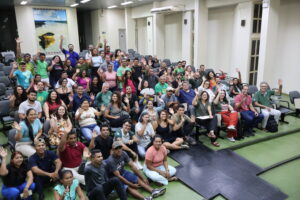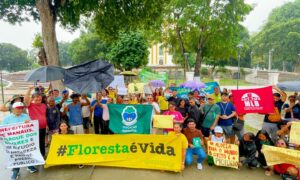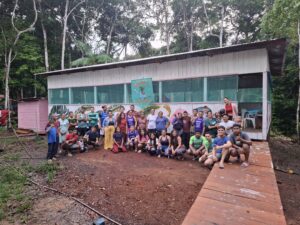The article surveys governance models, ecosystem and environmental services, natural capital in the Amazon, and shares successful experiences of an extractive-based bioeconomy in the Middle Juruá, AM.
By Bernardo Oliveira and Felipe Jacob Pires
The word future carries with it the weight of doubt. The future is, by nature, uncertain. But we can be sure of one thing: there is no viable future for the country and the world without the Amazon standing. What will happen from now on with the forest, is being built now. Built by the ideas of those who dare to project a world where respect for life is a priority.
It was thinking of a future where the Amazon will maintain its greatness and develop economically and socially, involving the peoples of the forest in this process, that the members of the Juruá Institute and SITAWI, associations that operate in the Middle Juruá region, in Amazonas, developed the article “Amazon in the 21st Century: natural capital, sustainable development and social justice.”
In a current context where the Amazon is placed at the center of global climate and environment, the study brings a discussion on strategies for the development of a more sustainable model for the biome, taking into account not only its environmental assets, but also looking at the social,cultural, and traditional populations for the maintenance of the forest.
A central concept addressed by the article for thinking about a living future for the forest is the bioeconomy. According to Felipe Jacob Pires, coordinator of territorial programs at SITAWI, “there are different narratives and understandings of what bioeconomy is. It is mainly related to the socioeconomic and environmental context of the region. ”

According to Felipe, bioeconomy is a practice that fits into the perspective of the green economy, an alternative to the current economic model, which in the last century has caused so much damage to our planet, both from an environmental and climatic point of view, as well as a social one. The bioeconomy in the Amazon offers sustainable economic production, based on its rich biodiversity, which uses its biological resources, combining science and new technologies to produce more sustainable products.
From bioeconomy, another concept emerges: socio bioeconomy – an opportunity to link the Amazonian sociocultural context to the paradigms that will be built with the bioeconomy projects in the region. This means that the main actors in this new way of thinking about economic production are in accordance with the peoples who live in the Amazon and still offer today, income possibilities in privileged areas, far from cities.
The ancestral knowledge of these populations, who have lived in an integrated manner with the forest for so long, enjoying their products without destroying the environment that shelters them, when combined with scientific knowledge, allows for the adequate and efficient management of the countless natural resources present in the region.
Included in this economic model are projects such as pirarucu management, sustainable fishing for the largest freshwater scale fish in the world, extraction of vegetable oils such as andiroba and murumuru oil, rubber extraction and many other possibilities for conscientious extractivism that respects the integrity of the environment.
“ The Amazon has immense potential for generating new business opportunities using its natural resources. There is already a very strong movement, involving companies, business accelerators, public authorities and several other institutions, promoting and supporting business initiatives with a more sustainable bias or, as many say, businesses with impact. It is already known that a standing forest is more profitable than a knocked one”, explains Felipe.
One of the questions raised by the study is how traditional populations, who are usually in the first link of the chain, that is, collecting and pre-processing raw materials, such as açaí, vegetable seeds, cocoa, should be involved in the production chain, ensuring their social rights and the fair sharing of the surplus.
Combining science and technology with traditional knowledge has never been as important and urgent as it is today. There is a great opportunity to create a truly sustainable economy model, developing new products, generating jobs and income for these populations and conserving the forest.
For Felipe, “forest people can and should benefit from this model, in investments to strengthen the management of their projects, in access to new production technologies, and in rural technical assistance, and in the protection of their territories.”
The Mid-Juruá region is a successful example of a bioeconomy based on socio-biodiversity. There are several ecological, social and institutional factors and principles that lead the region to a remarkable model of sustainable development, combining the conservation of biodiversity with the generation of income and the well-being of local areas.
This is due to the presence of various community associations that have organized themselves to make it possible to protect their territories and generate income for their residents, encouraging the participation of participants in different production chains and in environmental conservation.
Another proposal that the article brings is the payment for environmental services. It is known that the integrity of the Amazon is fundamental for regulating the global climate and the rainfall regime in Brazil. The people who live in the forest play a fundamental role in maintaining the benefits it offers. The idea here is that these people can get paid for this service, guarding their territories and conserving the environment.
Often, in projects to promote forest-based production chains, the effort and investment of populations in protecting and conserving natural resource management sites are not taken into account. Examples like this should be considered when thinking about who should be paid for the services that are being provided for the generation of humanity on the planet.
“We have a historic debt to the Amazon and its people. And we will only have sustainable development in this biome when we look inside, in the middle of a dense forest, intersected by winding rivers, and to the people who live there. ” concludes Felipe.






